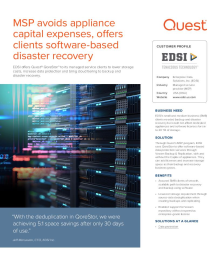 It’s gotten a lot more difficult to be a managed service provider (MSP), especially in 2020. Customer demands are at an all-time high for what they perceive as commodity services because of fierce competition. And margins are slim with a pricing race to the bottom to secure new customers.
It’s gotten a lot more difficult to be a managed service provider (MSP), especially in 2020. Customer demands are at an all-time high for what they perceive as commodity services because of fierce competition. And margins are slim with a pricing race to the bottom to secure new customers.
To be competitive, MSPs need ways to offer innovative services at affordable rates, without asking customers to make huge investments in new hardware – or having to do it themselves. No one has that kind of cash anymore, particularly small and medium sized businesses (SMBs) who need to get through the current economic crunch.
Data protection is a promising area where MSPs can expand their offerings by taking advantage of a software-defined storage platform for backup, recovery, replication and deduplication solutions combined with cloud tiering for different phases of storage. This kind of offering enables MSPs to extend flexibility and savings to their customers because they’re not passing on the upfront cost of a pre-configured backup appliance.
How does software-defined storage work? First consider that physical backup appliances are expensive – in the range of $30,000 - $50,000. And while they might hold petabytes of data, they can fill up fast considering how much data businesses retain for ordinary backup and compliance purposes. Large enterprises will typically buy these appliances and host them in their own data centers, or place them in the MSP’s data center.
But that’s a big outlay for an SMB. So even though they need a data protection solution, they want their MSP to provide the infrastructure, which means the MSP must do the upfront investment and hope they sell enough services to justify it. And backup appliances are great for onsite high availability and disaster recovery, but there are plenty of economies that can be achieved with cloud data storage as part of a hybrid strategy.
What’s the answer? MSPs can use a software-defined secondary storage platform to complement their backup solution and make it more efficient. It does this in a few ways by:
- using compression to reduce the size of each backup
- deduplicating data to slash storage costs
- reducing the time it takes to perform a backup
Higher efficiency will result in lower costs, but increased efficiency doesn’t only apply to on-premises storage. For organizations who are adopting a hybrid approach to data protection, a software-defined storage solution can make cloud storage more efficient as well. It allows administrators to take advantage of different cloud service tiers – shipping longer-term archived files to the least expensive storage levels.
With a software-defined storage platform, MSPs can provide cost-effective data protection services to their customers by optimizing their data center infrastructure. Using a combination of on-premises and cloud storage, MSPs can also make data protection affordable for SMBs.




